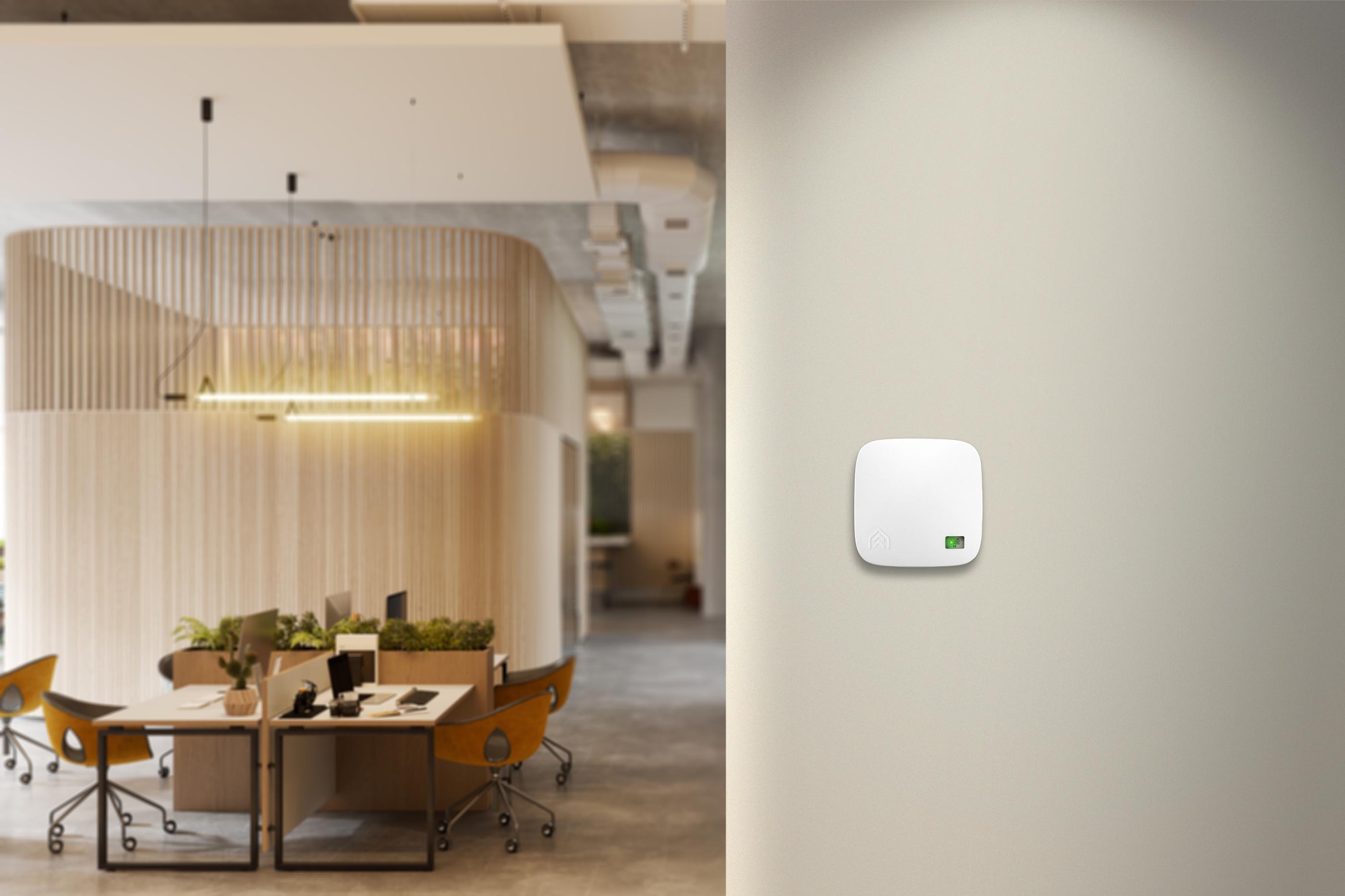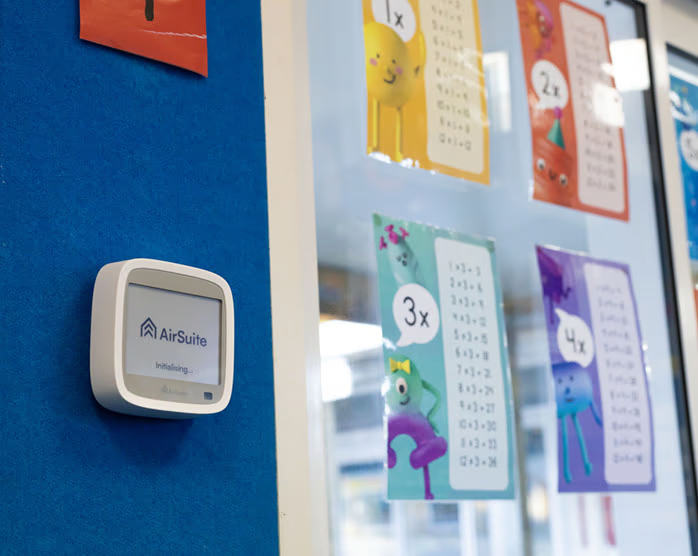
Support
Get help with setting up and using AirSuite sensors and software.
Deep dive: VOCs
All you need to know about measuring Volatile Organic Compounds (VOCs) with AirSuite monitors.
If you want to learn more about how the Volatile Organic Compounds sensor works inside your AirSuite monitor, you’re in the right place. Read on to discover:
- The dangers of high exposure to VOCs;
- How the sensors operate;
- How they calibrate, and;
- Technicalities to keep in mind.
Firstly, which materials or processes are responsible for VOC exposure?
Cleaning products, chemicals, craft and building materials, flames and combustion, vehicle fumes, and thousands of other processes and sources emit volatile organic compounds (VOCs).
Even installing new furniture or carpet from factories that undergo industrial processes, can expose you to VOCs.
Why’s it important to monitor VOCs?
Because they impact a building’s indoor air quality. At high levels, they can be very harmful. The health impact can range from mild airway irritation to serious respiratory issues and cancer.
What do AirSuite’s VOC sensors measure?
AirSuite sensors measure total VOCs (tVOCs) - that’s the total concentration of VOCs present in the air, measured in parts per billion.
An important limitation to understand is that tVOC sensors like this one cannot identify specific substances. This means the sensor will respond to everything from cleaning products and perfumes to off-gassing from new furniture or even cooking odours. The sensor cannot distinguish between harmful VOCs and relatively benign ones, so elevated readings don’t automatically indicate a health risk - they simply show that organic compounds are present in the air.
It is your responsibility to interpret the readings based on your knowledge of the space and its activities. For example, if you see a spike in VOC levels, you might want to investigate whether it coincides with the use of a cleaning product or the arrival of new furniture.
Interpreting Relative vs. Absolute Measurements
VOC sensors are most reliable for detecting changes and trends rather than providing precise absolute measurements. Think of your VOC readings as a “relative air quality indicator” - a sudden spike might indicate someone used hand sanitiser nearby, while a gradual increase over days could suggest ongoing off-gassing from new materials. The actual numerical values are less important than the patterns and changes you observe over time.
What affects the accuracy of VOC sensor measurements?
VOC sensors are extremely sensitive, meaning that if you expose them to high VOC levels, you’ll see the readings spike within seconds. Try it out by putting some hand sanitiser or perfume next to the sensor, and checking the readings via the AirSuite mobile app.
Several environmental factors can influence VOC sensor accuracy beyond the calibration process mentioned earlier. Temperature and humidity changes can cause readings to drift, and the sensor may show temporary fluctuations during weather changes. Additionally, the sensor’s location matters significantly - placing it near air vents, windows, or heat sources can result in more variable readings that may not represent the general air quality of the space.
How is the VOC sensor calibrated?
The sensor calibrates itself based on its past measurements on a daily basis, so if it is constantly exposed to high levels of VOCs it may appear not to detect them. For best results, keep the space well-ventilated so that the sensor is frequently exposed to fresh air.
It is unlikely that you’ll notice when the VOC sensor applies calibration adjustments, because of how often it self-calibrates. This is different from, for example, CO₂ sensors, which may suddenly increase or decrease sharply when the calibration occurs.
It is also important to note that when you first turn on your device, the VOC sensor needs to “warm up” - and we mean this in the literal sense! The sensor works by warming up a heating element so that it can provide accurate readings.
How long does it take for the VOC sensor to warm up?
When you turn your device on, the heating and calibration process will begin automatically.
The amount of warm-up time your sensor needs depends on the power mode it is operating in. In AirSuite devices, we apply a different power mode depending on whether the device connects to the Internet via Wi-Fi or LTE.
- Sense Wi-Fi operate in the standard power mode, and will take accurate readings after approximately 2 hours.
- On LTE devices (such as Sense LTE or Glance LTE), the VOC sensor operates in an ultra-low power mode that pre-heats the element at a lower rate to preserve battery life. On these devices, allow up to 12 hours for the sensor to take accurate readings.
When you first turn on your device, you’ll see the VOC readings slowly increase while the element is heating up, until reaching a steady state.
If your sensor reboots (for example, after applying an over-the-air update), or is only turned off for a short time, it will retain its previous calibration state and the warm-up period does not apply.
What happens if the VOC levels exceed healthy thresholds?
It is usually best to look for spikes in VOC levels to find where problems may be occurring. If you see a spike, try to identify what happened at that time. Did someone use a cleaning product, or did you have a delivery of new furniture?
If your VOC levels seem like they are always high, the sensor may simply need recalibrating. Try turning it off for a while and then turning it back on again. You can also try taking it outside into the fresh air, and leaving it there for a while before bringing it back inside. Put another sensor in the same location to see if they both report the same readings.
Usually, you will see their trends and sharp spikes line up (a strong indicator for the presence of VOCs), while the absolute values can differ considerably.
By default, AirSuite notifications are enabled for temperature, CO₂, VOCs and CO (if equipped). You will get a notification if VOCs exceed healthy levels.
To enable, disable or adjust thresholds, please refer to this support page.
When VOC readings may be misleading
There are situations where VOC sensors might provide readings that seem concerning but aren’t necessarily problematic. For example, cooking activities, use of alcohol-based products, or even certain plants can cause temporary spikes. Conversely, some serious air quality issues (like carbon monoxide or specific toxic gases) won’t register on VOC sensors at all. This is why VOC monitoring works best as part of a broader air quality assessment rather than as a standalone safety measure.
I want to measure particles like mould spores, dust, or exhaust fumes. What do I need?
AirSuite offers Particulate Matter (PM) and Carbon Monoxide (CO) sensors as optional add-ons. We fit them into the device before we ship it to you. Ask for one of these add-ons and we’ll do the rest.
Read more about Particulate Matter sensors and how they work here.
How do I interpret the data?
For the most meaningful data, focus on establishing baseline readings for your specific environment over several weeks. Note any recurring patterns - perhaps readings are consistently higher in the morning due to overnight accumulation, or spike during certain activities. Document any correlations between readings and activities, as this context makes the data far more actionable than the raw numbers alone.
AirSuite reports include colour-coded zones (green for good, red for bad) based on expert recommendations. However, these should be used only as a guide, due to it being hard to rely on the absolute readings of the VOC sensor, as discussed above. Therefore, they are not a substitute for expert analysis.
We’ve noticed some ongoing problems with our indoor air quality. What should we do?
It depends on what’s happening in your space. If it’s a factory environment, the solution may be obvious like installing some extraction fans. If you’ve investigated the cause and the answer is not immediately clear, it could be worthwhile to consult a specialist who can advise you on the best course of action to improve your indoor air quality.
A specialist will take particulate matter samples and send them to a laboratory for analysis. This will help you identify the source of the problem and take the necessary steps to improve your indoor air quality.
Alerts
- Configure alert thresholds
- Email Notifications
- Manage Alerts
- Mobile App Notifications
- Our Recommendations
Connectivity
- Battery Life
- LTE Coverage Guide
- Over-the-air Updates
- Troubleshoot Inactive LTE devices
- Troubleshoot Inactive Wi-Fi devices
- Wi-Fi Access Point Compatibility
- Wi-Fi or LTE?


